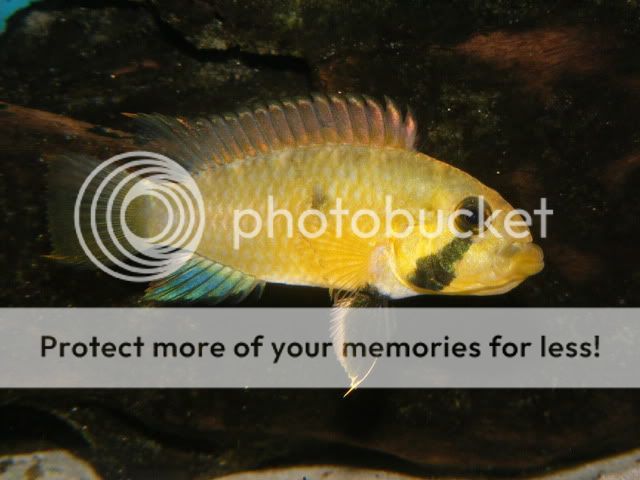:woohoo:Kelleri have spawned now! I win Gee.....although, when you have 2 males its pretty hard to get a spawn. :lol:
Woo hoo again
- Thread starter FF MkII
- Start date
Thanks all. Eggs are still in the cave but not holding out much luck for a viable spawn, if it is i think i could be one of the first in the country to have a viable spawn first time of asking as other reports tell of eaten eggs for the early spawns.
Hi all,
Best of luck with them, I know a few people in the UK have had them spawn.
They and A. barlowi are "primitive" mouth-brooders, where the eggs are laid in a cave like other Apistogramma sp. but the female picks up the wrigglers and incubates them in her buccal cavity.
This is one of Steve Chesters' holding <
 > via Apistogramma forums <http://forum.apistogramma.com/>
> via Apistogramma forums <http://forum.apistogramma.com/>
cheers Darrel
Best of luck with them, I know a few people in the UK have had them spawn.
They and A. barlowi are "primitive" mouth-brooders, where the eggs are laid in a cave like other Apistogramma sp. but the female picks up the wrigglers and incubates them in her buccal cavity.
This is one of Steve Chesters' holding <

cheers Darrel
Hi all,
cheers Darrel
No they aren't normally, all the species (other than these 2) are substrate brooders, when A. barlowi was first found and described (as A. "Malbruter/Mouthbreeder") there was a lot of discussion of whether it really was a mouth brooder or not. I called them primitive mouth brooders, but the technical term is "facultative larvophilic mouthbreeder".I love apistos, never knew there were mouth brooders tho.
cheers Darrel
I'm sure I read somewhere that one brood of kelleri was raised the conventional way, no mouth brooding at all.
Hi all,
I think this is the "facultative" bit. In Romer & Hahn (2008) "Apistogramma barlowi sp. n.: Description of a new facultative mouth-breeding cichlid species (Teleostei: Perciformes: Geophaginae) from Northern Peru"
<https://www.uni-muenster.de/imperia/md/content/landschaftsoekologie/mitarbeiter/hahn/roemer___hahn_2008_-_a_barlowi.pdf> it says that they observed mouth brooding in females (and males) when there was a strong current and fine sand as a substrate. They also had a female/fry on her own in tank with gravel and she only picked the fry up after several days, possibly because the fry were better protected between the gravel grains.
All Apistogramma females pick the fry up in their mouth to move them, so they think that this behaviour has developed from there. The genes for mouth brooding have led to greater fry survival, leading to more adults with this gene having more fry surviving etc until the whole species is a mouth brooder. The fact that A. barlowi/kelleri have huge mouths could be that they had these any and this predisposed them to mouth brooding or it could be that large mouths have been selected for since mouth brooding evolved because larger mouth = greater fry survival.
cheers Darrel
Probably the "kelleri" discussion on the BCA forum <http://www.britishcichlid.org.uk/phpBB3/viewtopic.php?f=6&t=867>.I'm sure I read somewhere that one brood of kelleri was raised the conventional way, no mouth brooding at all.
I think this is the "facultative" bit. In Romer & Hahn (2008) "Apistogramma barlowi sp. n.: Description of a new facultative mouth-breeding cichlid species (Teleostei: Perciformes: Geophaginae) from Northern Peru"
<https://www.uni-muenster.de/imperia/md/content/landschaftsoekologie/mitarbeiter/hahn/roemer___hahn_2008_-_a_barlowi.pdf> it says that they observed mouth brooding in females (and males) when there was a strong current and fine sand as a substrate. They also had a female/fry on her own in tank with gravel and she only picked the fry up after several days, possibly because the fry were better protected between the gravel grains.
All Apistogramma females pick the fry up in their mouth to move them, so they think that this behaviour has developed from there. The genes for mouth brooding have led to greater fry survival, leading to more adults with this gene having more fry surviving etc until the whole species is a mouth brooder. The fact that A. barlowi/kelleri have huge mouths could be that they had these any and this predisposed them to mouth brooding or it could be that large mouths have been selected for since mouth brooding evolved because larger mouth = greater fry survival.
cheers Darrel
Spawned again about 30 eggs this time and also my Atahualpa have wrigglers and my Centromochlus perugiae have spawned and just hatched! a good Xmas week so far.
